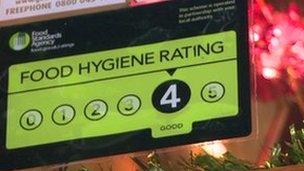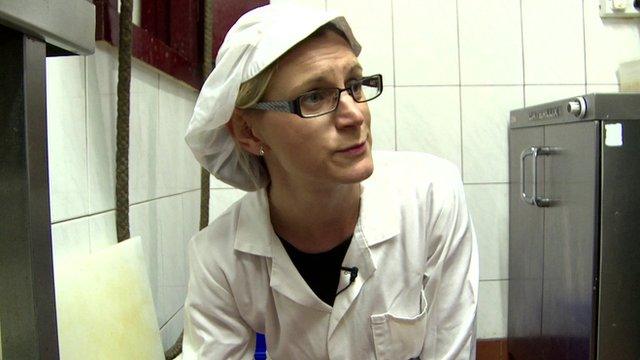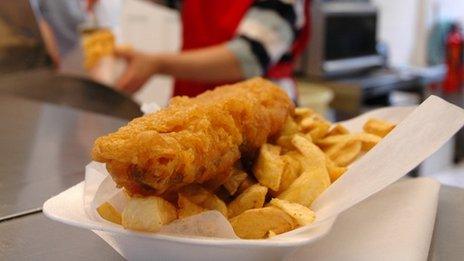How do restaurant chains compare for food hygiene?
- Published
- comments

Around one in three of the fast food outlets trading under the names of Dixy Chicken and Chicken Cottage failed to meet satisfactory levels for food hygiene when they were last inspected.
This is revealed in a BBC analysis of recent inspection data collated by the Food Standards Agency, external.
I have compared the hygiene records of some of the UK's most popular restaurant chains.
Other brands which also do badly include Pizza Gogo and Little Chef, where about one in five of the restaurants inspected were unsatisfactory.
On the other hand brands such as Nando's and Pret a Manger have hundreds of outlets, all of which reach an acceptable level.
Cleanliness
The ratings, external reflect how food is prepared, cooked and stored, as well as the cleanliness and condition of buildings and how the business is managed.
The Food Standards Agency collects these hygiene inspection ratings from nearly all councils in the UK and lets you search for individual scores for nearly half a million shops or restaurants on its website, external. You can also look at the food outlets in a particular area, external.
We scraped all this data from the FSA site to compile a national table comparing some leading restaurant brands. This shows what proportion of each chain's inspected outlets were found to be unsatisfactory - and the figures vary widely.
Many chains have no or very few establishments which are unsatisfactory, but there are some brands where a higher proportion of outlets failed to meet acceptable standards of food hygiene.
An FSA spokesperson said: "Food safety officers from local authorities will follow up with low-rated outlets and will work with them to improve hygiene standards."
A restaurant is considered unsatisfactory, external if it scores 0, 1 or 2 (out of 5) in England, Wales and Northern Ireland, or as "improvement required" in Scotland.
Many chains are franchise operations in which separately owned establishments trade under the same name and serve the same menu in line with the brand's requirements.
Corrective action
All the chains were given the chance to check the data, but most did not comment.
However, Little Chef says that it recognises it has to make progress and the company is initiating an investment programme to drive its hygiene standards up.
Patisserie Valerie says that it acts immediately to remedy unsatisfactory ratings and that "we await our next inspections with confidence". Wimpy also states it takes corrective action when any of its restaurants is found to be below par.
TGI Friday's, which scores well, says it is investing a seven-figure sum to achieve maximum five-star ratings in all its establishments. Zizzi, another chain with a good record, says it is pleased that the ratings reflect its operating standards.
The ability to compare different restaurants in this way illustrates the opening up of official information over the past few years, as well as some of the continuing obstacles.
Secret
It might seem hard to believe now, but before the Freedom of Information Act came into force in 2005, this sort of public health information was often kept secret by some local authorities.

One early case which helped to establish the principle that the public should have access to such data involved a hotel in Bridgend, in south Wales, which had numerous breaches of good hygiene.
Bridgend Council refused to release, external its inspection report, arguing that this would make it harder to work with local businesses to improve their practices. But the council was overruled in 2005 by the Information Commissioner, whose decision, external facilitated the open publication of food hygiene data.
The full data now used by the FSA is downloadable, but only on a council-by-council basis, external, which makes it harder for most users of the site to attempt any kind of national comparison between different brands or areas.
Large majority
The FSA says it receives and then re-publishes the data council-by-council and so does not hold all the information in the form of one dataset which it could make available in its entirety. It regards the aim of its service as enabling people to look up individual establishments where they might buy food or eat, rather than facilitating overall analysis.
Some caveats are needed about the figures. They are based on information uploaded to the FSA by individual local authorities by the middle of June, plus updates supplied to us by some chains. However some inspections will have taken place quite some time ago, and some authorities will be quicker at reporting the details, so there is no guarantee that it is all strictly up to date.
As well as this, the FSA doesn't have ratings for all outlets, because some are currently awaiting inspection or are exempt, some local authorities have not supplied information for all the establishments in their area, and a few councils (such as Greenwich) do not participate in the FSA scheme. Nevertheless the large majority of food outlets in the UK are covered.
For these reasons it is better to take the data as a rough evaluation for how different chains are doing rather than a set of exact measurements.
- Published5 January 2014

- Published28 November 2013
